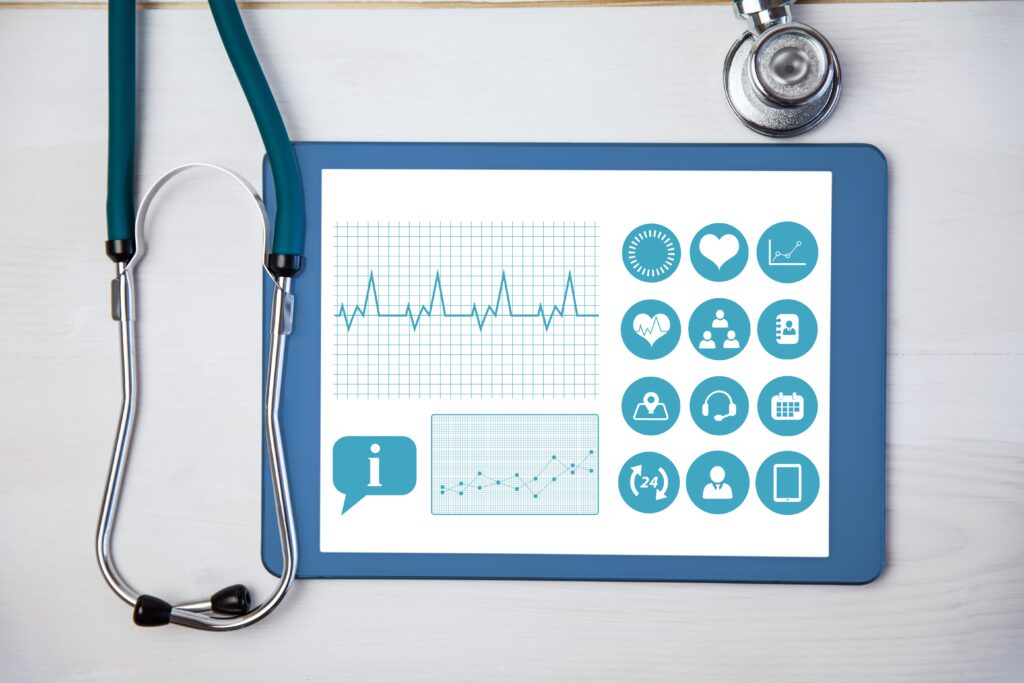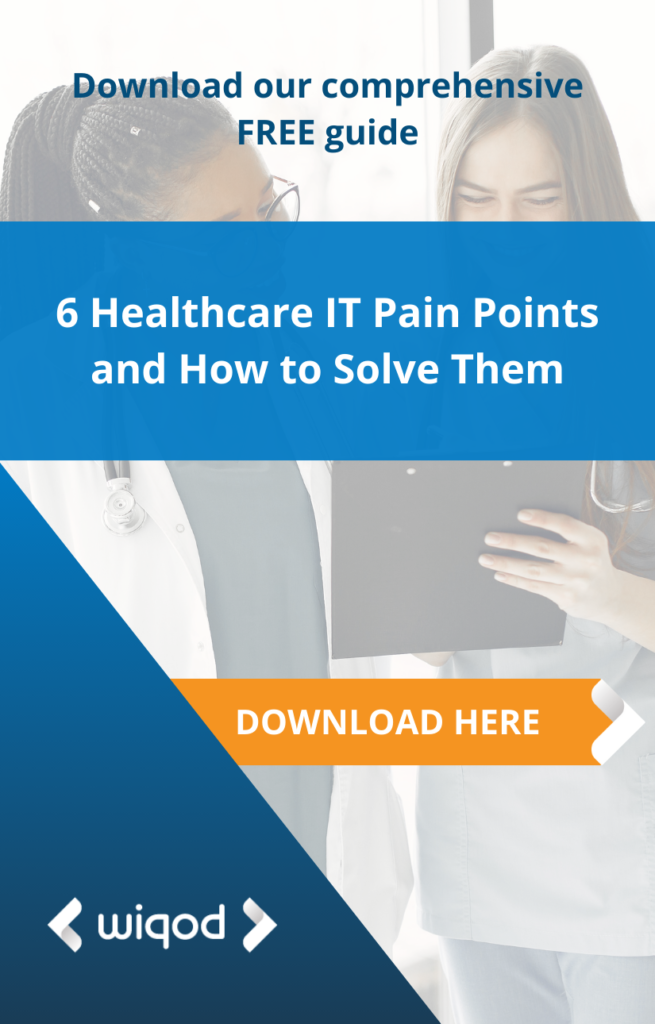In the rapidly evolving landscape of healthcare, technology plays a pivotal role in enhancing patient care, streamlining workflows, and improving overall efficiency. Electronic Health Records (EHR) and healthcare software have revolutionized the way medical professionals manage patient information and collaborate. However, these systems are not without their challenges. In this article, we will explore five common pain points and a bonus one in healthcare software and EHR systems and provide insights on how to effectively address them based on our experience working with our Healthcare clients on Wiqod.
1 – Interoperability Issues
Interoperability remains a significant pain point in healthcare software and EHR systems. Many institutions use multiple software solutions that often struggle to communicate seamlessly. This fragmentation can lead to inefficiencies, data discrepancies, and compromised patient safety.
Solution: Adopting standardized data exchange protocols, such as HL7 (Health Level Seven) and FHIR (Fast Healthcare Interoperability Resources), can facilitate smoother data sharing between different systems. Embracing Application Programming Interfaces (APIs) enables developers to create bridges between various software, promoting better interoperability and reducing data silos.

2 – User Interface Complexity
Healthcare professionals are frequently faced with intricate EHR interfaces that can be time-consuming and challenging to navigate. The complexity of these systems can result in user frustration, errors, and decreased productivity.
Solution: Designing user-friendly interfaces is crucial. Conducting usability tests and incorporating feedback from end-users can help streamline EHR interfaces. Implementing intuitive navigation, clear labeling, and customizable dashboards can empower healthcare providers to access relevant patient data efficiently.
3 – Security and Data Privacy Concerns
Healthcare software and EHR systems store sensitive patient data, making them prime targets for cyberattacks. Security breaches not only compromise patient privacy but can also disrupt operations and damage an institution’s reputation.
Solution: Implement robust security measures such as data encryption, two-factor authentication, and regular security audits. Adhering to industry standards like HIPAA (Health Insurance Portability and Accountability Act) ensures that patient data remains protected. Regular training for staff on cybersecurity best practices is also essential in preventing data breaches.

4 – Lack of Customization
Each healthcare institution has unique workflows and requirements. Off-the-shelf software solutions often fail to address these specific needs, leading to frustration and decreased efficiency.
Solution: Opt for customizable software or EHR systems that allow tailoring to the institution’s workflows. This could involve building in-house solutions or collaborating with software vendors to create customized modules. Flexibility in software design can significantly enhance user satisfaction and overall productivity.
5 – Integration of New Technologies
The healthcare field is constantly introducing new technologies such as telemedicine, AI diagnostics, and wearables. Integrating these innovations with existing software can be a challenging endeavor.
Solution: When developing or selecting healthcare software, consider its capacity to integrate with emerging technologies. Use modular software architecture that permits easy integration of new functionalities. Collaborate with tech-savvy professionals who can bridge the gap between healthcare expertise and software development.

BONUS 6 – Time-Consuming Documentation & Deteriorated Appointment Quality
One of the most prevalent pain points in healthcare software and EHR systems is the time-consuming nature of documentation. Healthcare professionals often find themselves spending excessive time inputting patient data, which can detract from direct patient care and lead to burnout. Here are some current metrics according to Microsoft-Nuance:
Operational inefficiencies
- 50% of physicians time spent documenting care
- Countless visits not billed due to unsubmitted documentation
- 3-5% lost revenue due to insufficient documentation and inaccurate coding
Growing physician burnout
- 42% of physicians are burned out
- 64% say burnout intensified due to the pandemic
- $4.6 billion a year attributed to the cost of provider burnout
- 90,000 physician shortage predicted by 2025
Sub-optimal clinician-patience experience
- 75% of U.S. consumers wish their healthcare experiences were more personalized
- 61% of patients would visit their healthcare provider more often if the communication experience felt more personalized

Solution: Harnessing AI for Documentation
Artificial Intelligence (AI) has emerged as a powerful solution to address the challenge of time-consuming documentation. Natural Language Processing (NLP) algorithms can transform spoken or typed language into structured data, enabling healthcare professionals to dictate patient information directly into the EHR system. Voice recognition technology powered by AI not only saves time but also minimizes the risk of data entry errors.
Moreover, AI-driven predictive typing can assist clinicians by suggesting contextually relevant phrases and terms as they type, allowing for quicker completion of medical notes. This reduces the cognitive load on healthcare professionals, enabling them to focus more on patient interaction and care.
Incorporating AI-powered chatbots within EHR systems can also streamline data retrieval. Instead of navigating complex menus, healthcare providers can ask natural language questions to retrieve patient information swiftly. This reduces the time spent searching for specific details, allowing for more efficient decision-making. Here are the benefits that Microsoft-Nuance finds in their AI implementation tests:
Increased Time Savings
- More facetime, focus, and communication
- Better patient relationship; more empathy and history knowledge
- Improved decision-making
- More comprehensive documentation supporting MEAT criteria
- Less cognitive load and burnout; decreased errors, increased job satisfaction
- Faster task management – refills, calls, messages
Better patient experience
- Improved adherence to orders and referrals
- Better physician relationship; more trust and information sharing
- Increased timely access to care; get needed care when needed
- Faster response to needs – refills, calls, messages
- Better coordination of care
Improve operational efficiencies
- Increased throughput/patient panel size/caseload and incremental services
- Improved clinician recruitment
- Reduced churn and overhead
- Reallocation of staff to higher level tasks and better staff utilization
- More referrals
- Enables appropriate coding, accelerated reimbursement and decreased denials
- Faster, accurate payments
- Controlled costs
- Improved care gap closure

Final thoughts
While healthcare software and EHR systems offer immense benefits, they come with their fair share of challenges. Interoperability, user interface design, security, customization, and integration of new technologies are common pain points that can hinder optimal performance. By adopting solutions such as standardized data exchange protocols, user-centered design, robust security measures, customization options, and modular architecture, healthcare institutions can navigate these challenges effectively.
Also integrating AI-powered solutions, such as voice recognition, predictive typing, and chatbots, can significantly expedite the documentation process, enabling healthcare professionals to allocate more time to patient care while maintaining accurate and comprehensive records. In doing so, they can unlock the full potential of technology to provide better patient care and streamline healthcare workflows.
As you explore the dynamic landscape of healthcare software development trends, we invite you to consider the comprehensive suite of solutions that Wiqod Custom Software Solutions has to offer. Our team specializes in creating tailor-made software solutions that align seamlessly with the unique needs and goals of healthcare organizations. From intuitive user interfaces to robust data security protocols, we prioritize excellence at every step of the development process.

